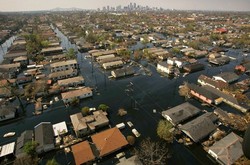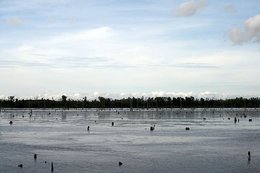Mister GO goes to trial
This is a significant Earth Day for coastal advocates.


A landmark civil suit began in federal court this week to consider claims by New Orleans-area property owners that the Army Corps of Engineers failed to properly maintain the Mississippi River Gulf Outlet, also known as MR-GO, a 76-mile-long navigation channel located adjacent to the city.

The lawsuit, which was filed by six plaintiffs whose homes in eastern New Orleans, the Lower 9th Ward and St. Bernard Parish were flooded during the 2005 hurricane, argues that the the channel was flawed in its design, construction and operation, and that those flaws intensified the hurricane's storm surge and flooded eastern New Orleans and St. Bernard Parish, reported the New York Times.
The shipping canal, which many critics have called "Hurricane Highway," is widely held responsible for destroying large parts of Louisiana's coastline and protective wetlands. Scientists say MR-GO's construction destroyed about 18,000 acres of marsh and 1,500 acres of cypress swamps. Scientists and coastal advocates also charge that MR-GO contributed to the devastating damage New Orleans suffered during Hurricane Katrina.
This is the first case against the Corps by Katrina flood victims to go to trail.
According to the New York Times:
The government has historically enjoyed strong legal protection against lawsuits related to collapsing levees. The Flood Control Act of 1928 bans suits against the United States for damages resulting from floods or floodwaters. In January 2008, a federal judge, Stanwood R. Duval Jr., ruled that the corps was immune in a different lawsuit related directly to the levee and floodwall failures during Hurricane Katrina in the city's major drainage canals.
This case, however, is different because MR-GO is a navigation canal, not a flood-control project.
The plaintiff's layers have called this "the last standing case" against the Corps, and its outcome could lead to settlements for hundreds of thousands of plaintiffs who have filed personal injury, property damage and wrongful death claims against the government over the hurricane's destruction.
"This is sort of the Exxon Valdez litigation of the government liability field," Oliver Houck, director of Tulane University's Environmental Law Program told the Lost Angeles Times of the groundbreaking lawsuit. "There's never been a case for this much in damages to so many people from such a gross act of government malfeasance."
"It's the most expensive catastrophe in United States history. And it's actually man made," Jonathan Andry, the plaintiffs' lawyer, told CBS News Monday.
In his opening comments, Judge Duval, who is hearing the case without a jury, also called the case "the first real trial" about Hurricane Katrina, the levees and the role of the federal government. "This is a significant case that could affect hundreds of thousands of people," Judge Duval said Monday. "You all know what this is about:...What did the Corps know, when did it know it, and when should it have known?"

The federally-funded MR-GO was dug into the swamps southeast of New Orleans in the 1960s as a shortcut between New Orleans and the Gulf of Mexico. For years coastal advocates charged that the Environmental Protection Agency and other federal agencies allowed energy companies to decimate Louisiana's coastal wetlands, the best buffers against hurricanes, with projects like MR-GO. Residents, environmentalists, civil rights groups and policy makers steadily argued for MR-GO's closure, as the channel continued to grow in size due to erosion, bringing with it daily tidal flows of salt water that killed wetlands, marsh and cypress swamp forests. Hurricane experts warned that the destruction of wetlands around MR-GO eliminated a key barrier to advancing storm surges, and that MR-GO's faulty design created a funnel effect, accelerating the force and strength of storm surges. But all these warnings went unheeded.
On Monday the plaintiff's expert on geology and the coastal environment, Sherwood M. Gagliano, testified that the channel was "one of the greatest catastrophes in the history of the United States." According to the New York Times, Gagliano cited reports from as early as 1957 that claimed the canal would pose a danger to the people of St. Bernard Parish and reports of his own dating from 1972 that warned of the increased flooding risk from wetlands destruction. He also testified that the Corps was aware of such research and even prepared a report in 1988 that mentioned the possibility of catastrophic damage to urban areas from MR-GO. Despite such assessments, Gagliano explained that the Corps did little to reduce the risk.
Yet, the Corps has consistently argued that the canal's effect during Hurricane Katrina was insignificant. But at the direction of Congress, the Corps has begun to close the MR-GO canal using 434,000 tons of rock.
The trial against the Corps is expected to take about a month, focusing on: the cause of the damage, the potential negligence of the Corps, and the extent of damages that could be owed if the Corps is found liable.
(Second photo: Bayou Bienvenue just north of the Lower Ninth Ward in New Orleans. This use to be a thriving cypress swamp working its way eastward to Lake Borgne, forming the northern geographic boundary of St. Bernard Parish. That was until MR-GO flooded the bayou with saltwater and killed the native cypress trees.)
